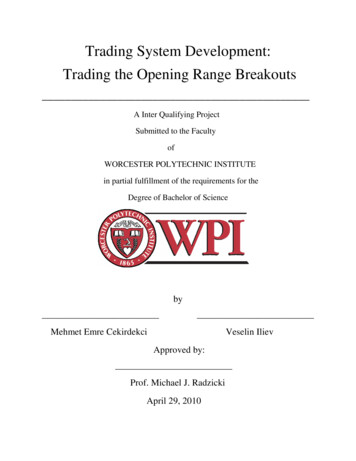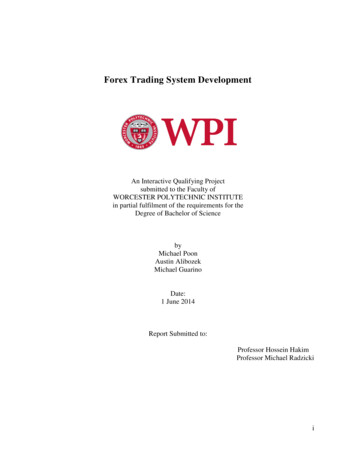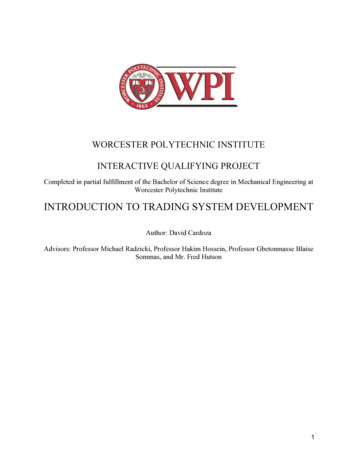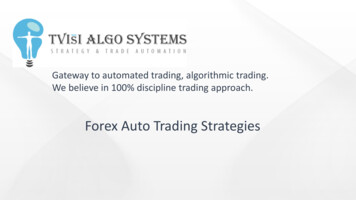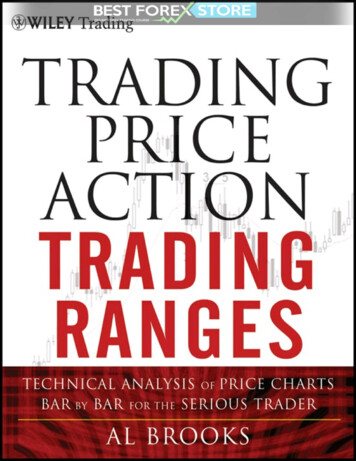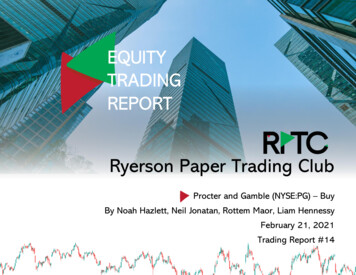
Transcription
Trading System DevelopmentAn Interactive Qualifying Projectsubmitted to the Faculty ofWORCESTER POLYTECHNIC INSTITUTEin partial fulfillment of the requirements for thedegree of Bachelor of SciencebyAttila KaraCamden LarivierePatrick FinnOlawole Tunde-Lukan
AbstractThe purpose of this IQP is to scientifically develop either a profitable automated tradingsystem or a profitable manual trading system. To accomplish this, members of the groupresearched fundamental concepts and theories about trading and how to develop trading systems.The members then began to implement techniques and tools to develop the trading systems.Next, team members scientifically developed their own systems that an ordinary citizen couldfollow. The team performed back testing and analyzed the systems through historical data to seehow the systems previously performed. Members allocated funds into each different systemthrough discussion of the team acting as a hedge fund. The team used data tools to recover theperformance of their different trading systems to give thorough analysis.1
AcknowledgementsThe IQP team would like to thank Professors Michael Radzicki and Hossein Hakim fortheir insight, guidance, and support throughout the Interactive Qualifying Project. We would alsolike to thank Worcester Polytechnic Institute for allowing us the opportunity to work on thisproject. Lastly, we would like to thank TradeStation for giving us the privilege to utilize theirservices and platform throughout the completion of this project.2
Table of ContentsAbstract . 1Acknowledgements . 2Table of Figures . 5Introduction . 9Background . 10An Introduction to Asset Classes . 10Stocks . 10Bonds . 11Options . 12Forward Contracts and Futures Contract . 13Currency Pairs . 14Commodities . 14Exchange Traded Funds . 15Mutual Funds . 15Sources of Data/Exchanges. 16Indexes . 16Exchanges . 19An Introduction to Trading Platforms. 22TradeStation . 22Different Types of Trading/Active Investing Systems . 23Theories. 23Manual Vs. Automated Trading Systems . 27Fundamental Vs. Technical Trading Systems . 28Strategies . 29Strategies . 34Strategy Objectives . 34High Winning Percentage . 34High Annual Return . 35Low Draw-Down . 35Robust Across Different Market . 36Low Time Commitment . 36Spend a Reasonable Amount of Time in the Market . 36Description of Systems . 38Strategy Terminology . 38Adaptive Moving Average Trading . 38Ichimoku Trading. 40Turtle Trading . 42Volatility Trading. 43Analysis of Systems . 46Adaptive Moving Average System . 46AMA Strategy Analysis- Tesla Motors Inc . 46AMA Strategy Analysis- IBM INC . 543
AMA Strategy Analysis- Nike Inc . 62AMA Strategy Analysis- Google Inc Class A . 70AMA Strategy Analysis- Full Portfolio . 78Ichimoku System . 86Ichi Strategy Analysis: USDJPY . 86Ichi Strategy Analysis: GBPJPY . 92Ichi Strategy Analysis: EURJPY . 100Ichi Strategy Analysis: AUDJPY. 107Ichi Strategy Analysis: Portfolio . 116Turtle Trend Following System . 122Apple (AAPL) . 122Amazon (AMZN). 130Google (GOOG). 137Netflix (NFLX) . 144Portfolio . 151Volatility System . 158System Of Systems Analysis . 164Conclusion . 173Adaptive Moving Average System . 173Ichimoku Trading System . 173Trend Following Turtle System . 174Volatility Trading System . 174System Of Systems . 175Works Cited . 176Appendices . 178Adaptive Moving Average Code . 178Ichimoku Code . 180Turtle Trading Code . 181Volatility Code . 1824
Table of FiguresFigure 1 Tesla Performance Summary (TSLA) . 46Figure 2 Monte Carlo Analysis (TSLA) . 47Figure 3 Monte Carlo Analysis (TSLA) . 48Figure 4 Monte Carlo Confidence Results (TSLA) . 48Figure 5 “30 Trades Ahead” Monte Carlo Analysis (TSLA). 49Figure 6 “30 Trades Ahead” Monte Carlo Report (TSLA) . 50Figure 7 “30 Trades Ahead” Monte Carlo Report (TSLA) . 50Figure 8 Optimal Position Size for Net Profit Report (TSLA) . 51Figure 9 Optimal Position Size for Net Profit Performance (TSLA) . 52Figure 10 Optimal Position Sizing for Rate of Return Report (TSLA) . 53Figure 11 Optimal Position Sizing for Rate of Return Performance . 53Figure 12 Performance Report (IBM) . 54Figure 13 Monte Carlo Analysis (IBM) . 55Figure 14 Monte Carlo Analysis Report (IBM) . 56Figure 15 Monte Carlo Confidence Levels (IBM) . 56Figure 16 “30 Trades Ahead” Monte Carlo Analysis (IBM) . 57Figure 17 “30 Trades Ahead” Monte Carlo Report (IBM). 58Figure 18 “30 Trades Ahead” Monte Carlo Report (IBM). 58Figure 19 Optimal Position Sizing for Net Profit Report (IBM) . 59Figure 20 Optimal Position Size for Net Profit Performance (IBM) . 60Figure 21 Optimal Position Sizing for Rate of Return Report (IBM) . 61Figure 22 Optimal Position Sizing for Rate of Return Performance (IBM) . 61Figure 19 Performance Summary (NKE) . 62Figure 24 Monte Carlo Analysis (NKE). 63Figure 25 Monte Carlo Report (NKE) . 64Figure 26 Monte Carlo Analysis Report (NKE). 64Figure 27 “30 Trades Ahead” Monte Carlo Analysis (NKE) .
Trading System Development An Interactive Qualifying Project submitted to the Faculty of WORCESTER POLYTECHNIC INSTITUTE in partial fulfillment of the requirements for the degree of Bachelor of Science by Attila Kara Camden Lariviere Patrick Finn Olawole Tunde-Lukan. 1 Abstract The purpose of this IQP is to scientifically develop either a profitable automated trading system or a
